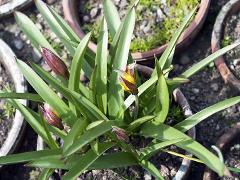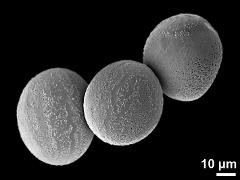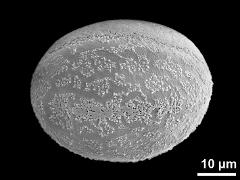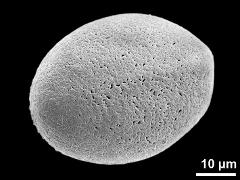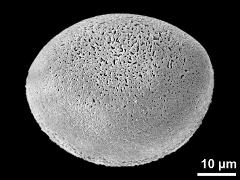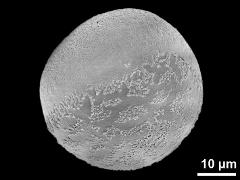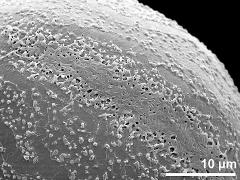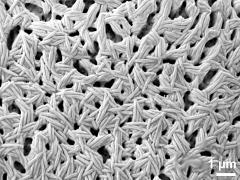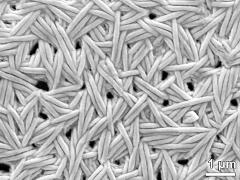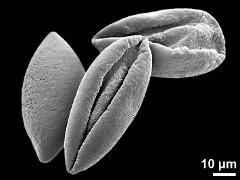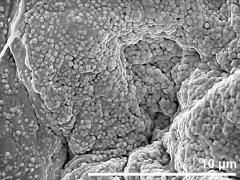Tulipa tarda
Taxonomy: Spermatophyta, Liliales, Liliaceae, Tulipa
Published: 2011-06-06
Pollen Description
Shape, Size and Aperture
pollen unit: monad, dispersal unit and peculiarities: monad, size (pollen unit): large (51-100 µm), size of hydrated pollen (LM): -, shortest polar axis in equatorial view (LM): -, longest polar axis in equatorial view (LM): -, shortest diameter in equatorial or polar view (LM): -, longest diameter in equatorial or polar view (LM): -, pollen class: sulcate, polarity: heteropolar, P/E-ratio: oblate, shape: -, outline in polar view: elliptic, dominant orientation (LM): -, P/E-ratio (dry pollen): oblate, shape (dry pollen): -, outline in polar view (dry pollen): no suitable term, infoldings (dry pollen): aperture(s) sunken, aperture number: 1, aperture type: -, aperture condition: sulcate, aperture peculiarities: aperture membrane ornamented, operculum
Ornamentation and Structure
LM ornamentation LM: -, nexine: -, sexine: -, SEM ornamentation SEM: rugulate, perforate, reticulate, suprasculpture SEM: -, TEM tectum: eutectate, infratectum: -, foot layer: -, endexine: -, intine: -, wall peculiarities: -, supratectal element: -
Miscellaneous
pollen coatings: -, reserves in cytoplasm: -, cell number: -, Ubisch bodies: present
Author(s) of diagnosis: Halbritter, H.; Buchner, R.
Pictures
Picture legend
- habitus, photographer: Buchner, R.
- hydrated pollen grains - fresh, rehydrated (water) & critical point dried & sputter coated with gold, photographer: Halbritter, H.
- polar distal view - fresh, rehydrated (water) & critical point dried & sputter coated with gold, photographer: Halbritter, H.
- polar proximal view (oblique) - fresh, rehydrated (water) & critical point dried & sputter coated with gold, photographer: Halbritter, H.
- equatorial view - fresh, rehydrated (water) & critical point dried & sputter coated with gold, photographer: Halbritter, H.
- equatorial view - fresh, rehydrated (water) & critical point dried & sputter coated with gold, photographer: Halbritter, H.
- aperture - fresh, rehydrated (water) & critical point dried & sputter coated with gold, photographer: Halbritter, H.
- exine surface - fresh, rehydrated (water) & critical point dried & sputter coated with gold, photographer: Halbritter, H.
- exine surface - fresh, rehydrated (water) & critical point dried & sputter coated with gold, photographer: Halbritter, H.
- dry pollen grains - dry, sputter coated with gold, photographer: Halbritter, H.
- Ubisch bodies on inner locular wall - fresh, rehydrated (water) & critical point dried & sputter coated with gold, photographer: Halbritter, H.
Literature
- (1988) Beiträge zur Pollenmorphologie der Gattung Tulipa. Wiss Z Friedrich-Schiller-Univ Jena, Math-Naturwiss Reihe 37: 177-183
- (1992) Studies on sporopollenin biosynthesis in Tulipa anthers. III. Incorporation of specifically labeled 14C-phenylalanine in comparison to other precursors. Bot Acta 105: 407-413
- (1999) Contributions to the pollen morphology and taxonomy of the Liliaceae. Grana 38: 20-30
- (1983) Occurrence of phenylalanine ammonia-lyase (PAL) in isolated tapetum cells of Tulipa anthers. Protoplasma 118: 219-224
- (1988) Studies on sporopollenin biosynthesis in Tulipa anthers. I. The development of an appropriate application method for radiolabeled precursors. Sex Pl Reprod 1: 125-131
- (1988) Studies on sporopollenin biosynthesis in Tulipa anthers. II. Incorporation of precursors and degradation of the radiolabeled polymer. Sex Pl Reprod 1: 132-139
- (1981) Pollen of Tulipa cv. Apeldoorn as an accumulation site of flavonol di- and triglycosides. Z Pflanzenphysiol 103: 291-296
Copyright and Citation
Cite this publication as:
Halbritter H., Buchner R. 2011. Tulipa tarda. In: PalDat - A palynological database. https://pc8.botanik.univie.ac.at/pub/Tulipa_tarda/200922;jsessionid=A427F8FC2282D3D03AE345F4A97F77C8; accessed 2025-01-10

